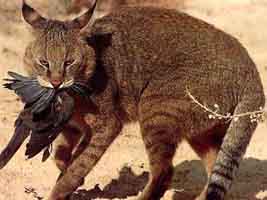- Jungle Cat
Taxobox
name = Jungle CatMSW3 Wozencraft | pages = 535]
status = LC
trend = down
status_system = iucn3.1
status_ref =IUCN2006|assessors=Cat Specialist Group|year=2002|id=8540|title=Felis chaus|downloaded=5 May 2006 Database entry includes justification for why this species is of least concern]

image_caption = Jungle cat with a bird in its mouth
regnum =Animal ia
phylum = Chordata
classis =Mammal ia
ordo =Carnivora
familia =Felidae
genus = "Felis "
species = "F. chaus"
binomial = "Felis chaus"
binomial_authority = Schreber, 1777The jungle cat ("Felis chaus"), also called the swamp lynx (although not closely related to thelynx es), is a medium-small cat, but is now considered the largest remaining species of the wild cat genus "Felis ". It averages 70 cm (28 in), plus a relatively short 20 cm (8 in) tail, and stands about 36 cm (14 in) tall. Weight varies across the range from 4 to 16 kg (8.8 to 35 lbs), though exceptionally heavy specimens have also been reported. Dependent on the subspecies the colour of the fur is yellowish-grey to reddish-brown. While vertical bars are visible on the fur of kittens, these bars disappear in adult cats. Due to the pointed ears and the long legs this cat resembles a small lynx (hence the name "swamp lynx").This cat is distributed over
Egypt , West andCentral Asia ,South Asia ,Sri Lanka andSoutheast Asia . It inhabits various habitats, for instancesavanna s,tropical dry forest s and thereedbed s along rivers and lakes, but it is not found inrainforest s. In some areas the jungle cat comes close to villages and may even live in deserted houses. The jungle cat lives in heights up to 2500 m, but is more common in the lowlands.Jungle cats hunt in the daytime for
rodent s,frog s andbird s. Those cats living close to bodies of water are able to swim and dive in order to catchfish .This species has been hybridized with the
domestic cat , producing the "chausie " breed.During mating season, the male "barks", sounding like a large dog. [ [http://www.bigcatrescue.org/jungle_cat.htm Jungle Cat ] ] In captivity, males have been observed to be very protective of their offspring, more than the females of their own species, or males of other cat species. [ [http://lynx.uio.no/lynx/catsgportal/cat-website/catfolk/chaus01.htm CSG Species Accounts: Jungle cat (Felis chaus) ] ]
ubspecies
* "
Felis chaus chaus ", South-eastTurkey , large parts ofCaucasus , North-westJordan , SouthernLebanon ,Syria ,Israel ,Iraq ,Iran ,Pakistan ,Afghanistan , SouthwesternRussia and most ofCentral Asia
* "Felis chaus affinis ",Kashmir toSikkim ,Nepal ,Bhutan ,Yunnan and North-westIndochina
* "Felis chaus fulvidina ",Thailand ,Myanmar ,Laos ,Cambodia andVietnam
* "Felis chaus furax "
* "Felis chaus kelaarti ",Sri Lanka
* "Felis chaus kutas ", westernIndia ,Pakistan
* "Felis chaus maimanah "
* "Felis chaus nilotica ", Northern Nile valley,Egypt
* "Felis chaus oxiana "
* "Felis chaus prateri ", westernIndia tatus
This species is often assessed as being in no danger and has therefore been ignored as a
rare species . In fact, in recent years a clearer picture has showed that this species could well be among the rarest of the small cats inAsia , and definitely the rarest one for which there is no protection within most of its current distribution. The species is assumed to be rare in its marginally African range. It is also assumed to be rather rare throughout the Middle East, where it is heavily hunted and poisoned (the only recent records fromJordan is of poisoned animals) and it is likely that this species is scarce in most parts of the Middle East. The species is assumed to be quite common in theCaucasus , although it is heavily hunted there for its fur.References
Wikimedia Foundation. 2010.
